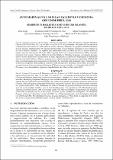Por favor, use este identificador para citar o enlazar este ítem:
https://hdl.handle.net/20.500.12958/3417Registro completo de metadatos
| Campo DC | Valor | Lengua/Idioma |
|---|---|---|
| dc.contributor.author | Goya Sueyoshi, Elisa | - |
| dc.contributor.author | Cardich Manrique de Lara, Carolina | - |
| dc.contributor.author | Llapapasca Lloclla, Miguel | - |
| dc.contributor.author | Márquez Manrique de Lara, José Carlos | - |
| dc.contributor.author | Meza Torres, María Andrea | - |
| dc.contributor.author | Rivadeneyra Villafuerte, Sofía | - |
| dc.contributor.editor | Instituto del Mar del Perú | - |
| dc.date.accessioned | 2020-05-19T03:59:45Z | - |
| dc.date.available | 2020-05-19T03:59:45Z | - |
| dc.date.issued | 2020 | - |
| dc.identifier.citation | Inf Inst Mar Perú 47(1), 2020, p. 65-79 | es_ES |
| dc.identifier.issn | 0378-7702 | - |
| dc.identifier.uri | https://hdl.handle.net/20.500.12958/3417 | - |
| dc.description.abstract | En noviembre – diciembre 2013 se efectuó la evaluación de aves marinas en el sitio piloto de las islas Chincha y Ballestas. Se registraron 658.652 individuos de aves marinas, identificándose 16 especies pertenecientes a nueve familias incluidas en cinco órdenes en las islas Chincha y Ballestas. Las especies más abundantes entre las bahías de Pisco y Paracas fueron el piquero peruano Sula variegata (Tschudi, 1843), el guanay Phalacrocorax bougainvillii (Lesson, 1837) y el zarcillo Larosterna inca (Lesson y Garnot, 1827). En las islas Ballestas y Chincha, el guanay y el piquero peruano fueron los más abundantes, encontrándose en etapa reproductiva. La población del pingüino de Humboldt Spheniscus humboldti Meyen, 1834 en su mayoría fueron adultos. De las doce especies registradas, el MINAGRI tiene seis categorizadas como amenazadas. El pingüino de Humboldt, está catalogado como “vulnerable” en la lista roja de especies amenazadas de la IUCN, y está incluido en el Apéndices I de CITES y de la CMS. El zarapito trinador Numenius phaeopus (Linnaeus, 1758) se encuentra incluido en el Apéndice II de la CMS. | es_ES |
| dc.description.abstract | ABSTRAC: The seabird assessment at the pilot site of the Chincha and Ballestas Islands was carried out in November - December 2013. A total of 658,652 seabirds were recorded, identifying 16 species belonging to nine families included in five orders on Chincha and Ballestas Islands. The most abundant species among the bays of Pisco and Paracas were the Peruvian booby Sula variegata (Tschudi, 1843), the guanay cormorant Phalacrocorax bougainvillii (Lesson, 1837), and the Inca tern Larosterna inca (Lesson and Garnot, 1827). In Ballestas and Chincha islands, the guanay cormorant and Peruvian booby were the most abundant and they were in their breeding stage. The population of the Humboldt penguin Spheniscus humboldti Meyen, 1834 were mostly adults. The Peruvian Ministry of Agriculture and Irrigation (MINAGRI in Spanish) has six of the twelve recorded species classified as endangered. The Humboldt Penguin, is listed as “vulnerable” on the IUCN Red List of Threatened Species, and is included on Appendix I of CITES and CMS. The whimbrel Numenius phaeopus (Linnaeus, 1758) is listed on Appendix II of CMS. | - |
| dc.language.iso | spa | es_ES |
| dc.publisher | Instituto del Mar del Perú | es_ES |
| dc.relation.ispartofseries | Informe IMARPE;47(1), 2020 | - |
| dc.rights | info:eu-repo/semantics/openAccess | es_ES |
| dc.rights.uri | https://creativecommons.org/licenses/by/4.0/ | es_ES |
| dc.source | Instituto del Mar del Perú - IMARPE | es_ES |
| dc.source.uri | Repositorio Digital IMARPE | es_ES |
| dc.subject | Aves marinas | es_ES |
| dc.subject | Depredadores superiores | es_ES |
| dc.subject | Ica - islas Ballestas | es_ES |
| dc.subject | Ica - islas chincha | es_ES |
| dc.title | Aves marinas en las islas Ballestas y Chincha, GEF-UNDP Perú, 2013 | es_ES |
| dc.title.alternative | Seabirds in Ballestas and Chincha islands, UNDP-GEF Peru, 2013 | es_ES |
| dc.type | info:eu-repo/semantics/article | es_ES |
| Aparece en las colecciones: | Informe vol. 47(1) 2020 | |
Ficheros en este ítem:
| Fichero | Descripción | Tamaño | Formato | |
|---|---|---|---|---|
| Informe 47(1) art 4.pdf | 816,63 kB | Adobe PDF |  Visualizar/Abrir |
Este ítem está sujeto a una licencia Creative Commons Licencia Creative Commons

